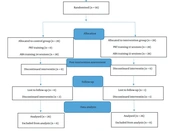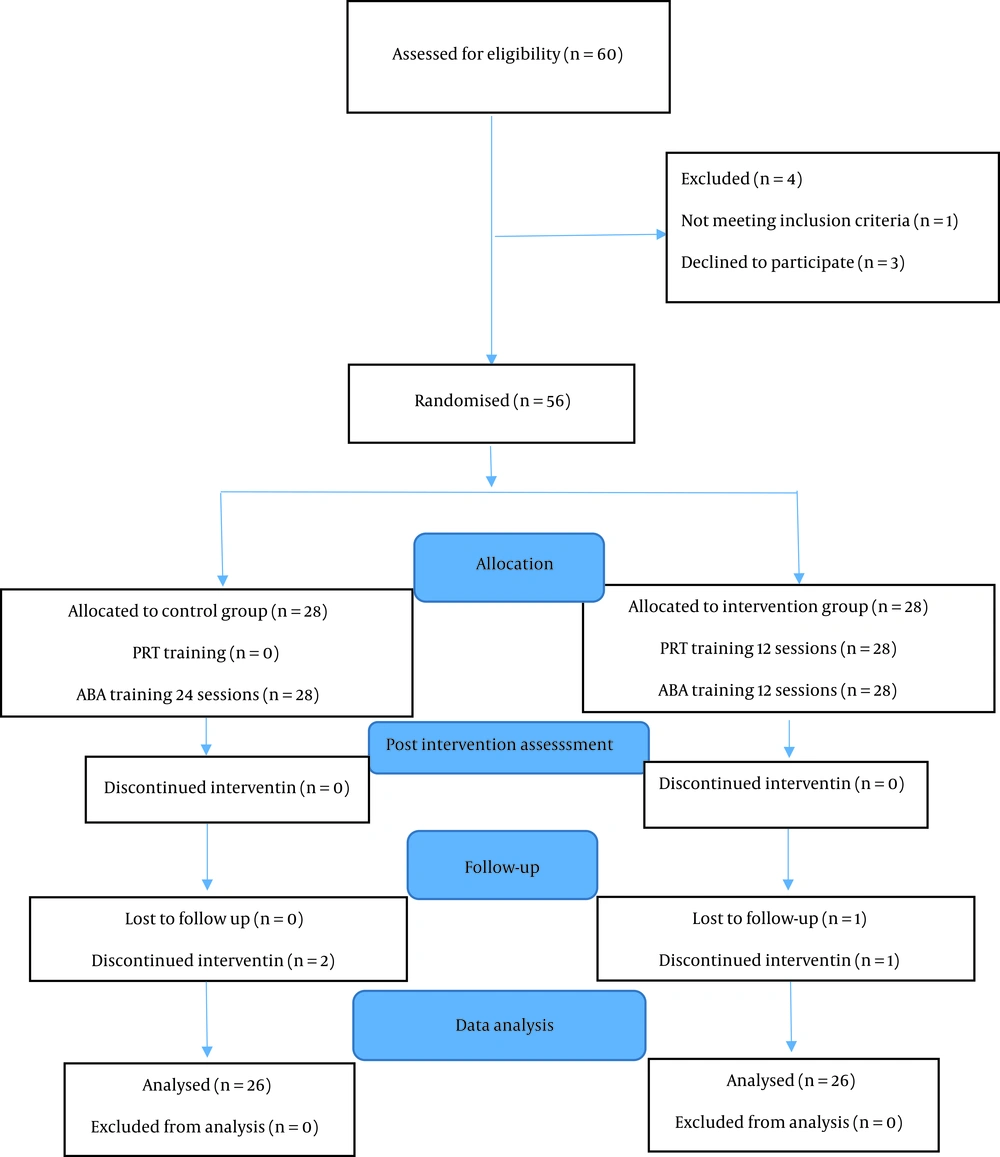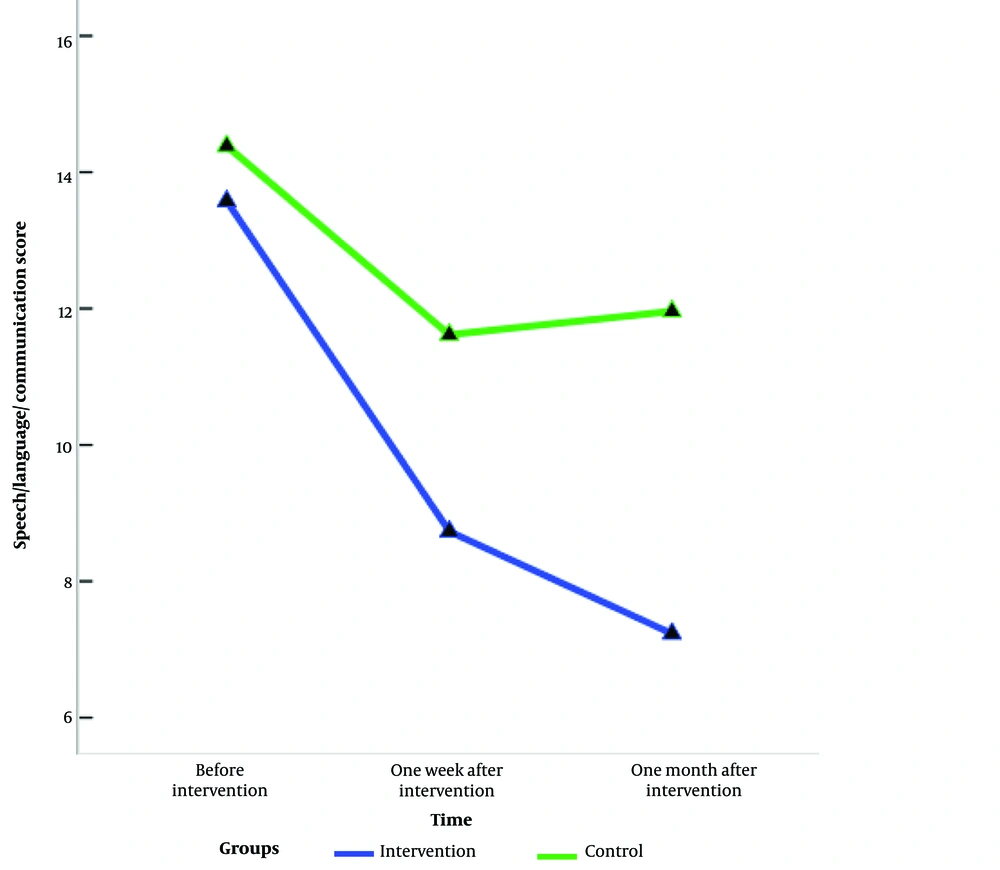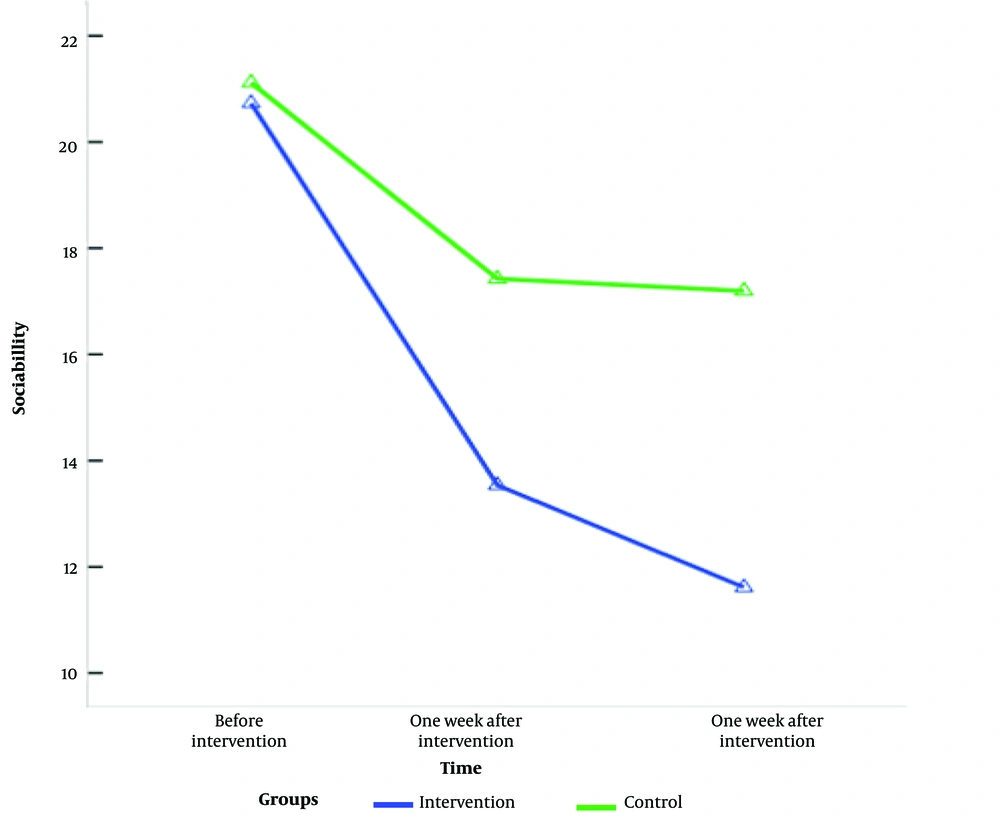1. Background
Autism spectrum disorder (ASD) is characterized by disordered communication and social interaction, repetitive behavior, and limited interests (1). Characteristics of ASD include medical conditions, difficulty in social relationships, language disorders, self-injury, repetitive and stereotyped movements, late-onset signs of the disorder, challenging and late diagnosis of the disorder, a lack of effective and reliable treatment, high costs for educational and medical services, and poor prognosis. These features put a lot of stress on the child's family, cause anxiety, depression, stress, and embarrassment for parents, and even lead to disputes that reduce their quality of life (2-5). In addition, the quality of life of children with ASD is lower than that of normal children in various dimensions of social, emotional, educational, and home activities (2, 6). Studies have shown that most of the behavioral problems of children with ASD are due to their speech problems (2) and that a lack of communication and language is a serious challenge for these children (7). About 50% of children with ASD face language deficits, and almost all of them have delayed onset of speech. Various areas of language, including semantic, syntax, pragmatic, and suprasegmental elements of speech, are also affected (8). Due to the negative effects of ASD on various aspects of the affected person's life and family, and given the increasing prevalence of this disorder, it is of great importance to provide these children with early and effective intervention. However, many of the treatments available are costly and time-consuming, so there is a need for timely, affordable, effective, and evidence-based treatments for children and parents (6). Studies have reported that parents, along with speech therapists, play very important roles in their children's language development (9).
Pivotal response treatment (PRT) originated in the naturalistic behavioral approach and assumes that children's disorders can be improved by environmental manipulations. This treatment provides children with interventions mainly embedded in purposeful and meaningful activities that are less structured compared to therapeutic activities offered by classic applied behavior analysis (ABA), are more child-centered (following the child’s lead), and offer natural reinforcement and intrinsically related rewards that are more efficient than extrinsic rewards (10).
Findings from systematic reviews and recent randomized controlled trials (RCTs) on the effectiveness of PRT reveal that parents can administer PRT techniques, and children with ASD show promising results regarding self-initiations, language development, general social communication skills, and collateral gains such as global functioning (11). In addition, PRT improves parent-child interactional patterns and decreases parental stress (12, 13).
However, we could not find any RCT in Persian using PRT for parental training to benefit non-verbal children with ASD. The lack of RCTs in this area and the existence of limited studies using PRT for non-verbal children motivated the present research. In this study, unlike a previous study conducted by a group of psychologists on verbal children aged 6 - 12 years (14), we included mothers of non-verbal children aged 2 - 6 years because, due to higher brain plasticity at this age, children's ability to acquire speech and language is much greater. Furthermore, the study was of the RCT type, and the sample size was much more than that of the previous study. The goal was to investigate the effectiveness of PRT training for mothers in improving the communication skills of non-verbal children with ASD.
2. Objectives
This study aimed to evaluate the effectiveness of PRT training for mothers in improving the communication skills of children with ASD.
3. Methods
3.1. Study Design and Participants
3.1.1. Sample Size
This study was a double-blind RCT. With the convenience sampling method, all the individuals who met the inclusion criteria and did not meet the exclusion criteria were included consecutively. In a study by Hardan et al. (15), the mean value of children's speech in the intervention group was 45.7 before the intervention and 64.5 after the intervention, and the percentage change was about 0.41. Since we wanted to observe the percentage change rate of 0.05 in the control group, considering a 95% confidence interval and 80% power, the final sample size was 26 patients in each group, according to the formula below. The subjects were randomly allocated into intervention and control groups using a table of random numbers.
3.1.2. Participants
This study was conducted on the clients of autism centers in Khuzestan Province, Iran, in 2017 - 2018. The population included all mothers of children with ASD and their children who visited the autism centers in Khuzestan Province. Along with a clinical interview, a pediatric psychiatrist made the diagnosis of ASD according to the instructions of the Diagnostic and Statistical Manual of Mental Disorders, Fifth Edition (DSM-5). The reason for choosing mothers was their availability and having more contact with children than fathers. The inclusion criteria for children with ASD were: (a) being in the age range of 2 - 6 years, and (b) using non-verbal communication means (gestures, eye gaze, and vocalization) to communicate with others. The inclusion criteria for mothers of children with ASD were: (a) Having a minimum education level of junior high school and (b) speaking Persian (being monolingual).
The mothers who participated in this study did so voluntarily and with their full consent. Those who did not cooperate enough in the study process or had irregular participation were excluded. At the beginning of the study, the following demographic information was collected by interviewing the mothers: Children’s age and sex, history of receiving speech therapy, history of receiving other psychological interventions, and the level of autism (Levels 1, 2, or 3), as well as mothers’ age, level of education, employment status, and the family's socioeconomic status. The speech/language/communication and socialization scores of the children were assessed using the Autism Treatment Evaluation Checklist (ATEC) before, 1 week after, and 1 month after the intervention.
3.2. Instrument
The ATEC was used to assess communication skills in ASD children. The minimum score obtained in ATEC is 0, which indicates the highest performance of the ASD subject, while the maximum score is 140, which indicates the lowest and weakest level of performance. The subscales of ATEC are (a) speech/language/communication, (b) socialization, (c) sensory/cognitive awareness, and (d) health/physical/behavior (16). In this study, only two subscales of speech/language/communication and socialization were used to assess the social and communication skills of children with ASD. Regarding the reliability of the ATEC, the Cronbach's alpha of each subscale is as follows: 0.92 For the speech/language/communication subscale, 0.83 for the socialization subscale, 0.87 for the sensory/cognitive awareness subscale, and 0.81 for the health/physical/behavior subscale (17). In addition, in a study that used Cronbach's alpha to assess the validity of the Persian version of ATEC, the alpha for the subscales of speech/language/communication, socialization, sensory/cognitive awareness, and health/physical/behavior was 0.87, 0.70, 60, and 0.85, respectively (18).
The first subscale, i.e., speech/language/communication, contains 14 items whose scores range from 0 to 28. The sociability subscale contains 20 items, and the participants can score from 0 to 40. The scores from each subscale are combined to calculate a TOTAL SCORE. A lower score indicates a lower severity of ASD symptoms. The ATEC can be administered online or in hard copy (19).
3.3. Intervention Method
Mothers of children with ASD in the intervention group received PRT training individually for 12 sessions by a speech-language pathologist (attending sessions lasting 1.5 hours once a week). The children in the intervention group also attended 12 sessions of routine ABA treatment, each lasting 1.5 hours per week. The children in the control group only attended 24 sessions of the routine treatment (ABA) at the autism center (attending 2 sessions per week, each lasting 1.5 hours). After the completion of the children's ABA sessions, individual PRT training sessions for the mothers were held in this center. The PRT training was administered through modeling; then, to ensure correct learning and application of the techniques, the mothers were asked to run the program as the therapist did. In addition, two therapists evaluated the mothers' performance at home by reviewing the recorded videos of mother-child interactions (Table 1).
| Session | Description |
|---|---|
| 1 | Talking with the mothers about the effect of parental involvement in increasing the effectiveness of speech therapy interventions for children with ASD |
| 2 | Asking the mothers to have a joint activity with the child and talk about his/her chosen objects and activities |
| 3 | Teaching the mothers to draw the child's attention to important people, objects, and activities in his/her environment |
| 4 | Teaching the mothers to provide clear learning opportunities appropriate to the child’s language development level |
| 5 | Teaching the mothers to follow the child’s lead and not to force him/her to pay attention to objects or events desired by the parents |
| 6 | Teaching the mothers to provide contingent reinforcement for the child |
| 7 | Teaching task variation to the mothers to avoid boring the child by drilling him/her repeatedly on a target language from |
| 8 | Teaching the mothers to use natural and direct reinforcers by providing objects and activities requested by the child |
| 9 | Teaching the mothers to reinforce all the incomplete clear attempts by the child to motivate him/her and to increase his/her communication frequency |
| 10 | Teaching interspersing acquisition and maintenance tasks to mothers by combining new tasks with previously mastered items |
| 11 | Teaching the mothers to reinforce the child’s independence by gradually removing the clues provided to him/her to enable him/her to use the target language and communication skills independently |
| 12 | Reviewing the educational techniques presented in the PRT training course and answering the mothers' questions |
Twelve PRT Training Sessions are Offered to the Mothers of Children with ASD
For randomization, according to the sequence of the participants' entrance into the study, the first author divided them consecutively into two groups. For example, participant 1 was placed in the intervention group, participant 2 in the control group, participant 3 in the intervention group, and so on.
For double-blinding, parental training and assessments were performed by 4 trained speech therapists who had no knowledge of the two study groups. The 2 evaluating speech therapists were different from the 2 therapists who performed the parental training. Moreover, the mothers themselves did not know which group they were in.
3.4. Data Analysis
In SPSS v. 23.0 (IBM Corp., Armonk, NY, USA) (20), the Kolmogorov-Smirnov test was applied to evaluate the normality of the data distribution. The Mann-Whitney U test, chi-square test, one-way analysis of variance (ANOVA), and one-way repeated measures ANOVA were used to compare the variables between these two groups.
4. Results
4.1. Participant Characteristics
The sample consisted of 52 mothers. Four out of the initial 56 participants left the study (Figure 1). The mothers had a mean age of 33.85 ± 4.44 years (age range: 25 - 41 years), and there were 52 children. The children included 16 boys (57.69 %) and 10 girls (42.30 %), with a mean age of 54.27 ± 10.17 months (age range: 36 - 72 months). The results of the chi-square test showed that the two groups did not significantly differ in terms of the child's sex, history of speech therapy, history of other therapeutic interventions, level of ASD, maternal level of education, maternal employment status, and household income level (P < 0.05). Based on the results of the Mann-Whitney U test, the two groups were similar in terms of the child's age and the mother's age (P < 0.05; Tables 2 and 3).
| Variables | No. (%) | Chi-square Test P-Value | |
|---|---|---|---|
| Intervention | Control | ||
| Sex of the child | 0.575 | ||
| Male | 16 (61.5) | 14 (53.8) | |
| Female | 10 (38.5) | 12 (46.2) | |
| History of speech therapy | 0.358 | ||
| Yes | 9 (34.6) | 6 (23.1) | |
| No | 17 (65.4) | 20 (76.9) | |
| History of other therapeutic interventions | 0.442 | ||
| Yes | 5 (19.2) | 3 (11.5) | |
| No | 21 (80.8) | 23 (88.5) | |
| Autism level | 0.794 | ||
| 1 | 4 (15.4) | 3 (11.5) | |
| 2 | 16 (61.5) | 15 (57.7) | |
| 3 | 6 (23.1) | 8 (30.8) | |
| Education level | 0.788 | ||
| Junior high school | 4 (15.4) | 3 (11.5) | |
| High school diploma | 16 (61.5) | 14 (53.8) | |
| Bachelor's degree | 4 (15.4) | 5 (19.2) | |
| Master's and PhD | 2 (7/7) | 4 (15.4) | |
| Mother's employment status | 0.229 | ||
| Employed | 6 (23.1) | 10 (38.5) | |
| Homemaker | 20 (76.9) | 16 (61.5) | |
| Income level | 0.368 | ||
| Low | 3 (11.5) | 5 (19.2) | |
| Medium | 18 (69.2) | 13 (50.0) | |
| High | 5 (19.2) | 8 (30.8) | |
Comparison of Basic Quantitative Characteristics Across the Intervention and Control Groups
| Variables | Mean ± SD | Mann–Whitney U Test, P-Value | |
|---|---|---|---|
| Intervention | Control | ||
| Child's age (mo) | 52.62 ± 9.95 | 55.92 ± 10.31 | 0.186 |
| Mother's age (y) | 34.04 ± 4.35 | 33.65 ± 4.61 | 0.748 |
Comparison of Basic Quantitative Characteristics (Age) Across the Intervention and Control Groups
One-way ANOVA was used to compare the speech/language/communication scores between the intervention and control groups. The results of this test showed that before the intervention, the speech/language/communication scores of the two groups were not significantly different from each other; however, 1 week and 1 month after the intervention, these scores in the intervention group were significantly lower than in the control group (Table 4).
| Groups | Score of Speech/Language/Communication, Mean ± SD | Repeated Measures Test, P-Value | ||
|---|---|---|---|---|
| Before the Intervention | 1 Week After the Intervention | 1 Month After the Intervention | ||
| Intervention | 13.58 ± 4.05 | 8.73 ± 4.53 | 7.23 ± 4.33 | < 0.001 |
| Control | 14.38 ± 3.87 | 11.61 ± 4.51 | 11.96 ± 5.32 | 0.001 |
| One-way analysis of variance P-value | 0.466 | 0.026 | 0.001 | |
Comparison of Speech/Language/Communication Scores Between the Intervention and Control Groups at Different Times
One-way ANOVA was used to compare the mean socialization score between the intervention and control groups. The results demonstrated that before the intervention, the socialization score of the two groups was not significantly different from each other; nevertheless, 1 week and 1 month after the intervention, the socialization score in the intervention group was significantly lower than in the group (Table 5).
| Groups | Mean Score of Socialization, Mean ± SD | Repeated Measures Test, P-Value | ||
|---|---|---|---|---|
| Before the Intervention | 1 Week After the Intervention | 1 Month After the Intervention | ||
| Intervention | 20.73 ± 7.15 | 13.53 ± 6.54 | 11.63 ± 5.83 | < 0.001 |
| Control | 21.12 ± 5.44 | 17.42 ± 5.78 | 17.19 ± 5.60 | 0.001 |
| One-way analysis of variance P-value | 0.828 | 0.029 | 0.001 | |
Comparison of the Mean Socialization Score Between the Two Groups at Different Phases
A one-way repeated measures ANOVA was performed to compare the changes in the socialization score within subjects at different phases of the study (Table 5). The results of this test showed that changes in the socialization score in both intervention and control groups were significant. A comparison of changes in the intervention and control groups (between-subjects effects) showed that the rate of change in the intervention group was significantly higher than in the control group (P = 0.044; Figures 2-3).
The pairwise comparison of the socialization score of the intervention group at different phases of the study revealed that compared to before the intervention, the socialization score had a significant decrease 1 week after the intervention (P < 0.001). Furthermore, the socialization score of the intervention group had a significant decrease 1 month after the intervention compared to 1 week before the intervention (P < 0.001). The pairwise comparison of the control group's socialization score at different phases showed that compared to before the intervention, the socialization score had a significant decrease 1 week after the intervention (P < 0.001). However, the control group's socialization score did not significantly change 1 week after the intervention compared to 1 week before the intervention (P = 0.495).
5. Discussion
This study evaluated the effectiveness of PRT training for mothers in improving the communication skills of children with ASD. It was found that 1 week after the intervention, speech/language/communication and socialization skills improved significantly in the intervention group compared to the control group. One month after the intervention, these skills remained significantly better in the intervention group. The repeated measures test indicated that the improvement in the intervention group was significantly higher than in the control group.
According to the ATEC, lower scores indicate better performance of children with ASD; thus, our findings suggest that parent-mediated PRT training is more effective than routine ABA therapy in improving speech/language/communication and socialization in ASD children. Based on this study, PRT was administered by the trained mothers, and an ongoing treatment option was created for the ASD children at home (21).
The greater reduction of speech/language/communication and socialization mean scores in the intervention group can be the result of the mothers' involvement in the intervention. One week after the intervention, we observed a greater reduction in the mean speech/language/communication and socialization scores in the intervention group than in the control group. This is in line with the findings of a similar study, which showed that PRT was significantly more effective than structured ABA in improving the communication deficits of ASD children (22).
Unlike the control group, a significant decrease in speech/language/communication and socialization mean scores was observed in the intervention group 1 month after the intervention. The significant improvement of the children in the intervention group can be attributed to the mothers' participation in the treatment program. These findings are consistent with those of Anan et al., who mentioned that behavioral interventions, along with parental education, can be useful in increasing the effectiveness of the intervention program for children with ASD. Moreover, parent-implemented interventions are more intensive, effective, and less expensive than therapist-implemented interventions (23). This is also analogous to Coolican et al.'s study stating that parental education improves the quality of family life by reducing stress and increasing leisure and recreation activities. In addition, parents who actively participate in delivering treatment interventions have more confidence in their ability to influence their child's development (24). Corsello also believes that parents who learn to follow their child’s lead and have a greater ability to communicate effectively with the child will help him/her develop more language and speech skills (25). Finally, Koegel et al. have shown that a lack of motivation to respond to environmental and social stimuli is a major disadvantage in children with ASD; in the PRT method, effective strategies are provided to increase children's motivation to interact with others (26). It is suggested that in an RCT with 2 control groups, the parents of ASD children in the intervention group remotely learn the PRT method by telerehabilitation (TR); the parents of ASD children in the first control group learn the PRT training in face-to-face sessions; and the ASD children in the second control group receive speech therapy services using the PRT method directly from a trained speech therapist. In this way, the effect of different methods of delivering PRT on the communication skills of children with ASD can be studied.
5.1. Limitations
A limitation of our study was that the statistical population involved ASD children whose parents visited autism centers in Khuzestan Province; therefore, caution should be considered in generalizing the results of the study to other children in Iran. Moreover, due to sample size limitations, it was not possible to assign another group that would receive PRT intervention directly from the therapist. Besides, due to time constraints, it was not possible to follow the stability of the effect of the programs over longer periods.
5.2. Conclusions
The results revealed that mother-implemented PRT intervention is a therapeutic approach that provides a continuous home treatment environment for ASD children. Besides, the intervention can improve the socialization and communication skills of children with ASD.



